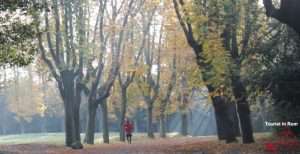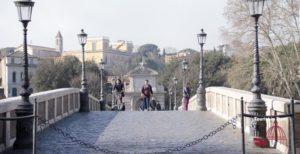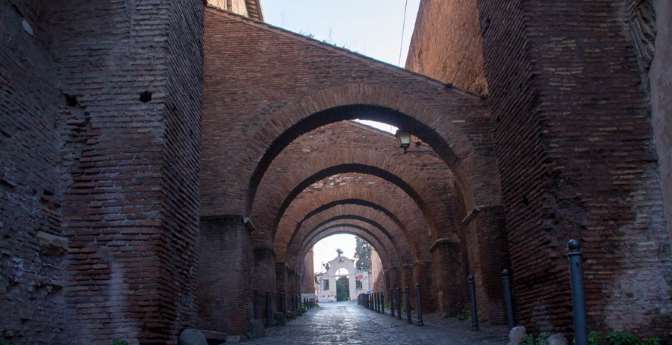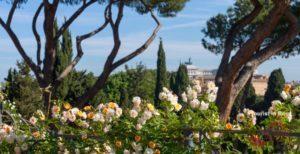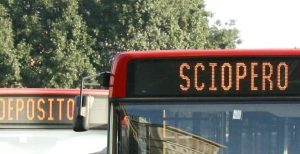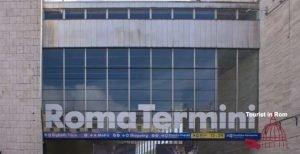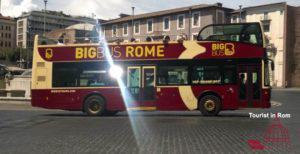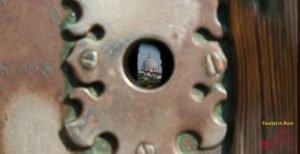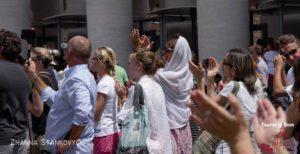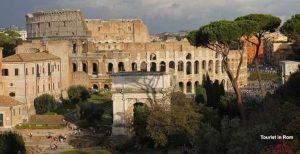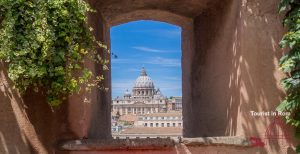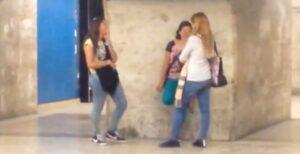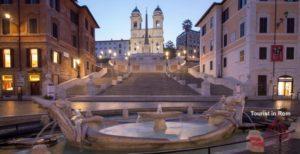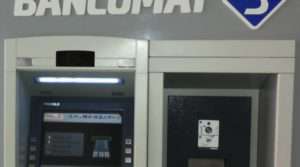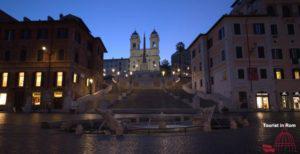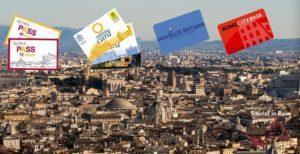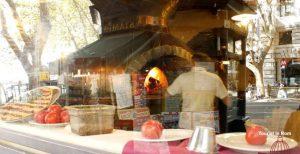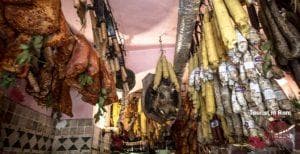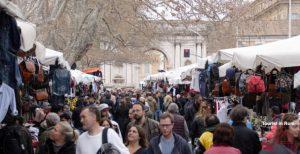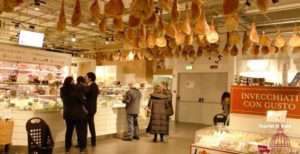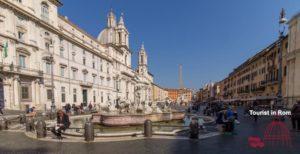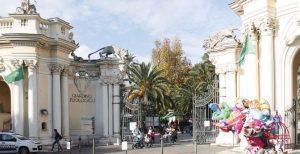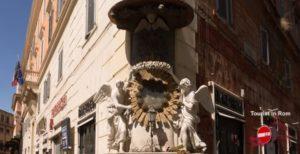Caelius and Oppius are 2 of the 7 hills of Rome and have been inhabited since ancient times. They offer remarkable sights and historical sites.
On the hill Caelius there are several important churches. Under the park of Colle Oppio is buried Nero’s golden house and there is a basilica with a horned Moses.
Partner-Links helfen uns dabei, unsere Informationen kostenlos bereitzustellen. Für abgeschlossene Buchungen erhalten wir eine Provision – ohne Mehrkosten für Sie! Mehr
Partner links help us to provide our information free of charge. For completed bookings we receive a commission – at no extra cost to you! More
I link dei partner ci aiutano a fornire gratuitamente le nostre informazioni. Riceviamo una commissione per le prenotazioni completate, senza alcun costo aggiuntivo per voi! Di più
Time planning
Unfortunately, it often happens that one stands in front of closed doors at the churches on the two hills. The opening hours of the basilicas somewhat scarce:
- Giovanni e Paolo 08:30-12, 15:30-18
- Santo Stefano Rotondo 10-13, 15:30-18:30
- San Clemente 9-12:30, 15-18:00
- San Pietro in Vincoli 8-12:30, 14-18, from April – September until 19:00.
The Caelian Hill
The Celio was already included by Romulus in the city. In addition to the numerous basilicas, there are various excavations on the Celio, some of which can be visited. The hill of the Celio is 168 ft high.
As part of the underground construction work, graves from the Iron Age and an aqueduct from the 3rd century BC were found in the underground of the Celio.
For the ascent you can take the Via Claudia from the Colosseum, from the Circus Maximus the Salita di San Gregorio, which runs behind the tracks of the tram.
Particularly suggestive is the climb over the Salita di San Gregorio. The climb leads past a convent founded by Pope Gregory I in the 6th century. You then come to an ancient piece of road called Clivo di Scauro, which passes by the Basilica of the Saints Giovanni and Paolo.
Basilica SS. Giovanni e Paolo
The Basilica of St. John and Paul is a popular wedding church. The basilica dates back to the 4th century. Under the basilica there are Roman houses and the martyrs John and Paul are said to have lived there. The Case Romane del Celio below the Basilica, are open to the public. Tickets
To the left of the bell tower is a gate. If it’s open, you can look down there on supply halls of the Colosseum.
Villa Celimontana
Villa Celimontana dates back to the 16th century. Its entrance is just above the Basilica of St. John and Paul. Another entrance is at the highest point of the hill on Via della Navicella. There stops the bus line 81.
Unfortunately, the villa is not very well maintained. Nevertheless, it’s very popular with the Romans. In the villa there is an obelisk as well as numerous statues and ancient monuments. The building is the seat of the Italian geographical society. Jazz concerts are held here in the summer.
Santo Stefano Rotondo

The Basilica of Santo Stefano Rotondo dates back to the 5th century and has a circular layout. It is similar to the plan of the Anastasis of the Church of the Holy Sepulcher in Jerusalem.
The basilica belongs to the Jesuit College Pontificum Collegium Germanicum Hungaricum. It is Hungarian national church.
Basilica di San Clemente
As you descend from Caelius on Via di Celimontana, past the Military Hospital on the right, you come to the Basilica di San Clemente.
The basilica of St. Clement has its origins in the 4th century. Its present appearance has been preserved from the 12th century.
Under the basilica are ancient excavations that can be visited. Among other things, there is a Mithras temple from the 1st century. You can also visit the excavated rooms of a Roman house and a small catacomb. Guided tours
Oppian Hill
Opposite the Basilica of St. Clement rises the Oppius Hill on the other side of Via Labicana. The hill extends to the Basilica of Santa Maria Maggiore and Termini Station.
In the park of the Oppio is a square with a fountain dedicated to the reformer Martin Luther. A building of Nero’s Domus Aurea is located in the underground of the Park.
The area between Park and Via Cavour belongs to the district of Monti and is characterized by picturesque winding lanes.
Domus Aurea
The Domus Aurea was built by Emperor Nero as his city villa after the fire in 64 BC. Also parts of the Palatine belonged to the area. Where the Coliseum is today was an artificial lake. After Nero’s death, the villa was filled in and fell into oblivion. It was rediscovered in the 15th century when a boy fell in a crack and found himself in a strange grotto with wall paintings.
The Domus Aurea lies in the underground of the Oppius hill. It is part of the Colosseum Archeopark and excavations and security work are carried out during the week. At the weekend, the Domus can be visited and with the help of virtual reality you can experience what the Domus once looked like. Guided tours
San Pietro in Vincoli

If you follow the Largo della Polveriera on the eastern edge of the park, you will pass a building of the University La Sapienza and then arrive to the Basilica of St. Peter in chains – Basilica di San Pietro in Vincoli.
The basilica was built in the 5th century and has undergone numerous restorations and alterations over the centuries. It shows the relics of the chains of St. Peter.
In the rear right part of the basilica is the Moses of Michelangelo. This important work of the Renaissance was to serve as a tomb for Pope Julius II and was completed in 1645. Michelangelo put horns on Moses due to a misinterpretation of Hebrew texts which understood horns instead of sunbeams. Moses just came down from Mount Sinai with the Ten Commandments and found his people dancing around the golden calf.
The basilica is open 8-12:20 and 3-6pm, in the legal summer time to 7pm.

In the square of the Basilica you can find a staircase that goes under a house. It is called the staircase of the Borgia. In the building with the balcony above the arch is said to have lived a mistress of the Catalan Pope Alexander VI Borgia, the famous Vanozza Cattanei from Mantua, mother of the notorious children of Pope Alexander, Cesare, Lucrezia and Giovanni. The staircase leads to Via Cavour and on to the heart of the Monti district and the Cavour metro station.
Monti is a very picturesque neighborhood and is well suited for a cozy evening with a well-kept meal.
The 7 hills
The seven hills of Rome are the Capitol Hill and the Aventine (tour proposal Aventine – Testaccio), the Palatine Hill, the Caelius, the Oppius as part of the Esquilin, the Viminals Hill and the Quirinal Hill.
Between Celio and Oppio, the Via Labicana leads from the Colosseum in an easterly direction. Sometimes you read about the Opium Hill. That is a wrong translation. The name is attributed to a warrior named Oppius, who defended Rome in the 6th century BC.
Other proposals
Combine our suggestions to put together your program in Rome. Any suggestion is good for half a day or more.

